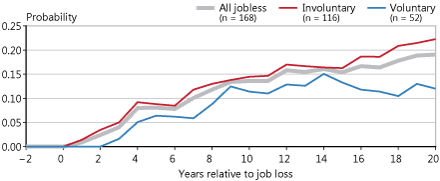Long-Term Joblessness and Disability Benefits Receipt
October 2014Long-term joblessness may be associated with a variety of factors connected to later life health
Past research suggests that reduced earnings 1 or the loss of health insurance 2 following job loss may influence long-term health through multiple pathways. One measure that can help capture a long-term association between job loss and subsequent health is disability benefits receipt.
Male workers aged 25–55 who experienced long-term joblessness in the 1980–1982 twin recessions had an increased probability of receiving DI or SSI benefits decades later
At 20 years after their job loss (voluntary or involuntary), these workers had a 25 percentage point higher likelihood of receiving DI or SSI benefits (22 percentage points for involuntary job leavers and 28 percentage points for voluntary job leavers).
The increased probability of DI or SSI benefits receipt was reduced when men with pre-existing work limitations were removed from consideration, but only for voluntary job leavers
The increase in the probability of DI or SSI benefits receipt after 20 years was 19 percentage points for men with no work limitation prior to their job loss. For involuntarily job leavers, the probability increase remained at 22 percentage points, but fell to 12 percentage points for voluntary job leavers.

| Years relative to job loss | Jobless (n = 168) |
Involuntary (n = 116) |
Voluntary (n = 52) |
|---|---|---|---|
| -2 | −0.003 | −0.002 | −0.003 |
| -1 | −0.002 | −0.002 | −0.002 |
| 0 | −0.001 | −0.001 | −0.001 |
| 1 | 0.009 | 0.014 | −0.001 |
| 2 | 0.024 | 0.035 | −0.002 |
| 3 | 0.040 | 0.050 | 0.016 |
| 4 | 0.080 | 0.092 | 0.051 |
| 5 | 0.081 | 0.088 | 0.064 |
| 6 | 0.078 | 0.085 | 0.062 |
| 7 | 0.101 | 0.118 | 0.059 |
| 8 | 0.118 | 0.130 | 0.088 |
| 9 | 0.134 | 0.138 | 0.125 |
| 10 | 0.136 | 0.145 | 0.114 |
| 11 | 0.136 | 0.147 | 0.110 |
| 12 | 0.158 | 0.170 | 0.129 |
| 13 | 0.155 | 0.167 | 0.126 |
| 14 | 0.161 | 0.164 | 0.151 |
| 15 | 0.154 | 0.163 | 0.133 |
| 16 | 0.167 | 0.187 | 0.118 |
| 17 | 0.164 | 0.186 | 0.114 |
| 18 | 0.178 | 0.209 | 0.105 |
| 19 | 0.189 | 0.215 | 0.130 |
| 20 | 0.191 | 0.223 | 0.120 |
SOURCE: Couch, Kenneth A., Gayle L. Reznik, Christopher R. Tamborini, and Howard M. Iams. 2013. “Economic and Health Implications of Long-Term Unemployment: Earnings, Disability Benefits, and Mortality.” Research in Labor Economics, 38: 259–305.
NOTES: Results are based on fixed-effects methods, using data from the 1984 Survey of Income and Program Participation and longitudinal records from the Social Security Administration. Wave 3 topical modules provided information on the 1980–1982 recession. Linked administrative data provided information on respondents' covered earnings and disability benefit receipt before and after the SIPP, from 1979–2003.
All content is simplified for presentation. Please see source material for full details and caveats.
The findings and conclusions presented in this summary are those of the authors and do not necessarily represent the views of the agency.
Background
- The long-term effects of job loss can have significant implications for health and therefore the receipt of disability benefits.
- Examining the effects of the 1980 to 1982 recession on those who experienced long-term unemployment may provide insight into future patterns for individuals affected by the Great Recession (2007–2009).
Key Terms
- Long-term joblessness is unemployment lasting more than one year.
- DI benefits are benefits received through the Social Security Disability Insurance program.
- SSI benefits are disabled, non-elderly benefits received through the Supplemental Security Income program.
- Work limitation is a health condition limiting or preventing the type of work an individual can do.
- Involuntary job leavers are individuals who listed the reason for losing their last job as being laid off or discharged. Voluntary job leavers are those who listed any other reason.
1 Couch, Kenneth A., and Dana W. Placzek. 2010. “Earnings Losses of Displaced Workers Revisited.” American Economic Review, 100(1): 572–589.
2 Gruber, Jonathan, and Brigitte C. Madrian. 1997. “Employment Separation and Health Insurance Coverage.” Journal of Public Economics, 66: 349–382.